During my almost 6 months stay in Okinawa this year I had the chance of visiting a lot of interesting Karate and Kobudo places.But I didn’t always have time to write about it, at that time.
Now I have!
Prepare to see 10 great, awesome, remarkable and wonderful Karate places I visited in Okinawa but never told you about.
But beware! These places are mostly historical places. That’s great if you – like me – love history.
Not everyone does.
So… if you are not somewhat familiar with the Okinawan Karate and Kobudo history, or simply aren’t interested in that sort of stuff to begin with, then I guess some of these places can seem a little boring.
You can just look at the pictures then and make up your own history.
I didn’t write that much anyway…
For the rest of you, here we go:
1. The Secret Cave of Channan
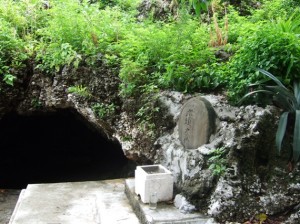
According to my sources in Okinawa, this cave was the place where a shipwrecked Chinese sailor (or pirate?) named Channan took refuge, a very long time ago. This cave is actually in the middle of a graveyard, in the hills of Tomari.
Spooky place to live in.
Many noted Karate experts and researchers today have done research on this man, Channan (Or Chiang Nan which maybe was his original name), but it is still a rather big mystery exactly how he influenced Okinawan Karate.
Some people even think he was the originator of the Pinan/Heian kata we have today.
All we know for sure is that many old Karate masters came here, to this exact cave, to get instruction from master Channan in the secret art of Chinese boxing…
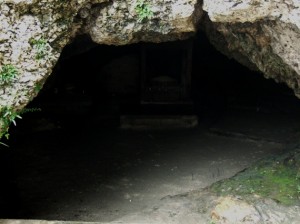
Here you can see the inside of the cave in a little more detail. Notice the altar, incense and so on, neatly stuffed inside. This cave is nowadays considered “holy” or sacred, so I didn’t enter.
Not that I’m afraid of ghosts or anything…
Anyway, an interesting place.
2. The Jundokan and The Bust of Miyagi Chojun
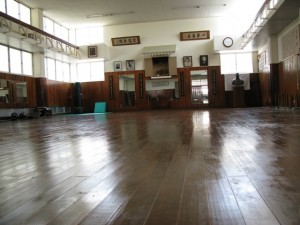
The Jundokan is one of the more famous dojos in Okinawa, especially in Goju-ryu circles (sorry for the strange angle in the picture!).
The Jundokan is a true old-style Okinawan dojo, and you can really smell it in the air when you enter the place. The walls are covered with original calligraphy (by Miyagi himself, and others) and along the walls are various old-school strength training implements.
Well used, I can tell you!
But, at the far end of the dojo is what truly makes Jundokan unique among Okinawan dojos:

A life-size bust of the founder of Goju-ryu himself, Mr. Miyagi Chojun (1888-1953).
It’s really nice.
Remind me to make on of those of myself to my dojo!
3. Ippon-Do – Martial Arts Store.
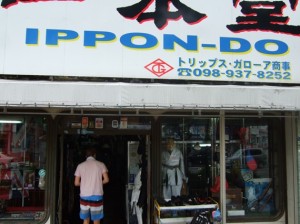
For those of you who think Shureido is the only martial arts store in Okinawa… think again.
Ippon-Do is located… umm… let’s just say it’s far away. Maybe that’s why it’s not that popular (?), but believe me, they have some interesting stuff!
It’s the complete opposite of the traditional Shureido store.
Or what do you say about nunchaku that glows in the dark or a plethora of samurai wigs!? They even had clown costumes…
Let’s just say that Ippon-Do is the wacky cousin of Shureido.
Worth a visit though!
Just for the fun of it.
4. Monument of Matsumora Kosaku
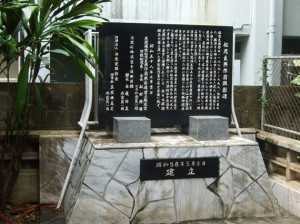
Conveniently located in a playground (!) in Tomari, stands this monument in memory of Matsumora Kosaku (1829 – 1898), famous expert of Tomari-style Karate. He was a big influence on today’s Karate, passing along the foundation to famous kata like Chinto/Gankaku, Passai/Bassai, Wansu/Wanshu/Empi, Naihanchi, Rohai, Wankan etc…
But I still don’t understand why the monument is in the middle of a playground?!
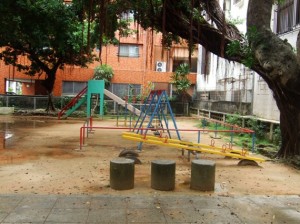
It felt weird…
5. Karate Museum in Nishihara
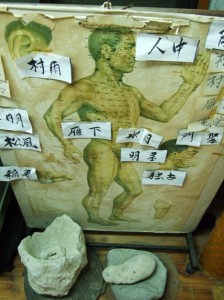
I have been to two Karate museums in Okinawa.
This one, located in Nishihara, close to Ryukyu University, is perhaps the most famous of the Karate/Kobudo museums in Okinawa. And you could tell from the tourists that came almost every day.
Here are some, actually:
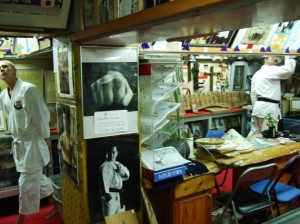
Run by Mr. Hokama, a noted Goju-ryu Karate researcher, it has many interesting items, especially in the Kobudo section. There is even a picture of me (at the age of maybe 12) on the wall in there!
It’s true!
(But that’s another story…)
There is a small fee for entering, and another for taking photographs, if I remember correctly. I never had to pay though… contacts you know!
If you visit, try to get some of Mr. Hokama’s excellent calligraphy!
He’s a real master.
6. The Tomb (Haka) of Motobu Choki
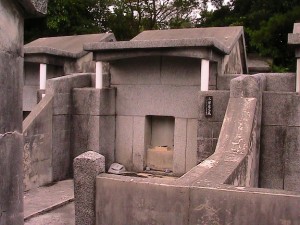
This is the final resting place of notorious Karate expert (and undefeated street fighter!) Motobu Choki (1870-1944).
He was an interesting figure, to say the least. But, as you can see, this tomb isn’t.
It’s a modern, new-style grave (haka in Japanese). It actually stands next to 20 identical haka, like it’s mass produced or something.
A bit sad.
And when you look closer, you discover something strange at the front:
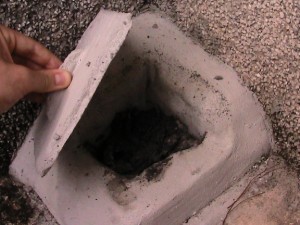
Believe it or not, this is ashes of… money.
They actually burn money for the spirits of their ancestors!
And they wonder why Okinawa is the poorest of the Japanese prefectures…
7. The Tomb (Haka) of Motobu Choyu
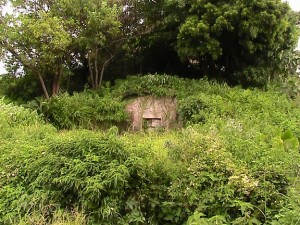
This place was just crazy.
It’s impossible to get there!
We tried maybe 25 times, but finally admitted defeat. The vegetation was just too dense!
But as we know “if you can’t beat them, join them”. So I managed to crawl and duck and jump and scratch my knees a little, “becoming one” with the djungle… and eventually snap this picture you see above.
Motobu Choyu (1857 – 1927) was the elder brother of Motobu Choki (see #6, above) and thus got a little nicer and more traditional burial place.
I doubt any people ever come here though…
8. The Naha-te Monument of Miyagi Chojun and Higaonna Kanryo
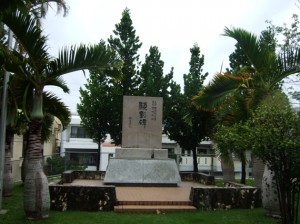
This is a more famous monument, and I bet every serious Goju-ryu stylist has been here, paying respects to Miyagi Chojun and his principal teacher Higaonna Kanryo (1853-1916). Conveniently located near the Fukushuen-garden, in the middle of a schoolyard (!).
What’s up with these monuments and their strange locations anyway?
If you approach this huge stone monument you can see something interesting (at least if you have your glasses on):
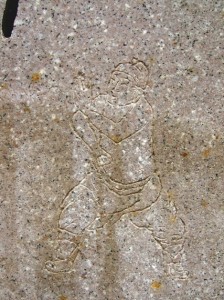
Small neatly carved fighters, showing Bubishi-style self-defense postures.
Cool.
9. The Yara Castle (Yara Gusuku)

Located in the town of Chatan stands this castle (or fortress) which once belonged to Mr. Yara, a famous Karate and Kobudo expert of Okinawa.
I just realized that I only took a photo of the sign!
I knew I forgot something…
Anyway, today we know this master as Chatan Yara (Yara from Chatan). For example, we have the kata Chatan Yara Kushanku in Karate, and Chatan Yara no Kon, Chatan Yara no Sai and Yaraguwa no Tonfa in Kobudo, which were all passed down (or developed) from master Yara.
His castle is the only thing remaining of him today, except his kata.
Be sure to learn them!
10. The Abandoned Dojo of Higa Seiko – Shodokan.
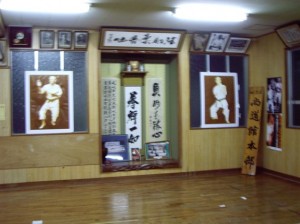
Higa Seiko (1898-1966) was one of the most famous Naha-te masters to ever walk the soil of Okinawa, and this is his former dojo – The Shodokan. The wooden sign to the right is supposed to hang outside I believe, but since the dojo is not being used anymore is has been taken down.
(By the way, sorry for the blurry photo. I guess I had to many fermented soybeans in me).
This dojo was quite big for an Okinawan dojo, and I think I saw some Kobudo weapons here and there too.
Here is a picture of the founder of the dojo himself, Mr. Higa:
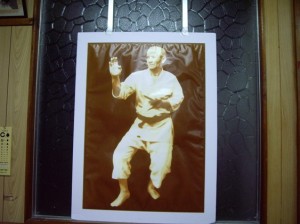
Well, I think that’s about it.
That was 10 places I visited in Okinawa, but never told you about.
Now I have.
So I can sleep easy!
Of course I visited many other places too, like the monument of Chan Miigwa (Kyan Chotoku), the tombs of Matsumura Sokon, Itosu Anko, Hanashiro Chomo and Soeishi Udun among others, the Shotokan Pines of Sueyoshi Park dedicated to Funakoshi Gichin and his son Gigo (those were nice!), the Tokyo Budokan (huge!) a couple of other dojos (Keishinkan, Shinbukan, Bunbukan, Aja Kouminkan, the abandoned dojo of Nakama Chozo etc…) and quite a few other Karate and Kobudo places.
You can do it too.
You just need to be a Karate and Kobudo nerd like me!
You will also need the right contacts… and a lot of spare time.
So, what are you waiting for?

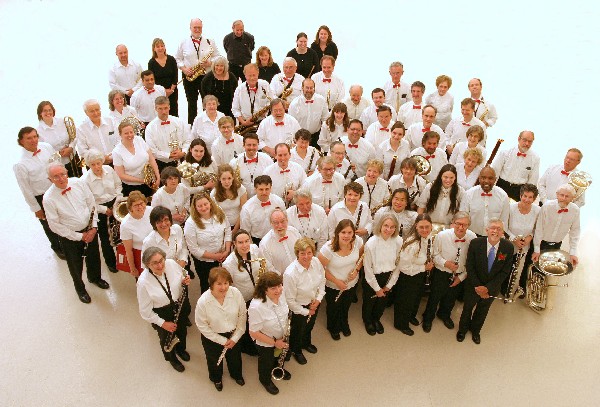
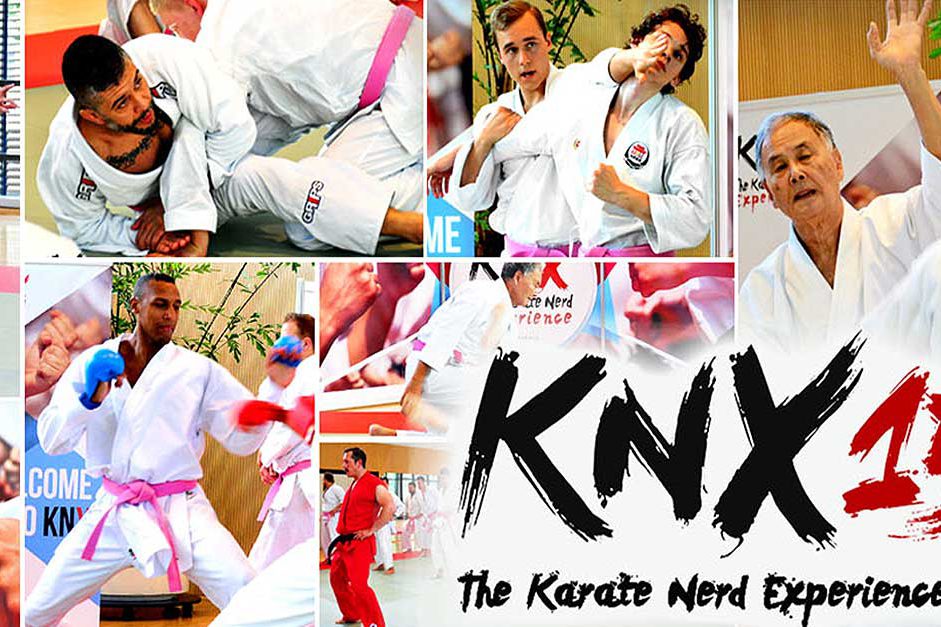
23 Comments